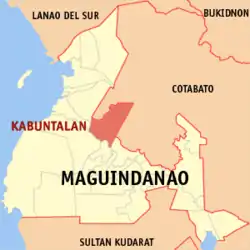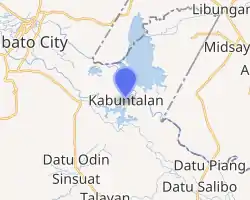Kabuntalan
Kabuntalan, officially the Municipality of Kabuntalan (Maguindanaon: Ingud nu Kabuntalan; Iranun: Inged a Kabuntalan; Tagalog: Bayan ng Kabuntalan), is a 5th class municipality in the province of Maguindanao, Philippines. According to the 2015 census, it has a population of 17,276 people. [3]
Kabuntalan | |
|---|---|
| Municipality of Kabuntalan | |
 Map of Maguindanao with Kabuntalan highlighted | |
OpenStreetMap 
| |
.svg.png.webp) Kabuntalan Location within the Philippines | |
| Coordinates: 7°07′N 124°23′E | |
| Country | |
| Region | Bangsamoro Autonomous Region in Muslim Mindanao (BARMM) |
| Province | Maguindanao |
| District | 1st District |
| Barangays | 17 (see Barangays) |
| Government | |
| • Type | Sangguniang Bayan |
| • Mayor | Salaban G. Diocolano |
| • Vice Mayor | Datu Rahaf D. Diocolano |
| • Representative | Datu Roonie Q. Sinsuat Sr. |
| • Electorate | 10,623 voters (2019) |
| Area | |
| • Total | 371.08 km2 (143.27 sq mi) |
| Elevation | 4.0 m (13.1 ft) |
| Highest elevation | 36 m (118 ft) |
| Lowest elevation | −1 m (−3 ft) |
| Population | |
| • Total | 17,276 |
| • Density | 47/km2 (120/sq mi) |
| • Households | 2,401 |
| Economy | |
| • Income class | 5th municipal income class |
| • Poverty incidence | 62.49% (2015)[4] |
| • Revenue | ₱59,384,441.35 (2016) |
| Service provider | |
| • Electricity | Maguindanao Electric Cooperative |
| Time zone | UTC+8 (PST) |
| ZIP code | 9606 |
| PSGC | |
| IDD : area code | +63 (0)64 |
| Climate type | tropical climate |
| Native languages | Maguindanao Tagalog |
| Website | www |
It is formerly known as Tumbao.[5]
The town was part of the province of Shariff Kabunsuan from October 2006 until its nullification by the Supreme Court in July 2008.
Geography
Barangays
Mother Kabuntalan is politically subdivided into 17 barangays.
- Bagumbayan
- Buterin
- Dadtumog (Dadtumeg)
- Gambar
- Ganta
- Katidtuan
- Langeban
- Liong
- Lower Taviran
- Maitong
- Matilak
- Pagalungan
- Payan
- Pedtad
- Pened
- Poblacion
- Upper Taviran
Climate
| Climate data for Mother Kabuntalan, Maguindanao | |||||||||||||
|---|---|---|---|---|---|---|---|---|---|---|---|---|---|
| Month | Jan | Feb | Mar | Apr | May | Jun | Jul | Aug | Sep | Oct | Nov | Dec | Year |
| Average high °C (°F) | 31 (88) |
32 (90) |
32 (90) |
32 (90) |
31 (88) |
29 (84) |
29 (84) |
29 (84) |
30 (86) |
30 (86) |
30 (86) |
31 (88) |
31 (87) |
| Average low °C (°F) | 21 (70) |
21 (70) |
21 (70) |
23 (73) |
23 (73) |
23 (73) |
23 (73) |
23 (73) |
23 (73) |
23 (73) |
23 (73) |
22 (72) |
22 (72) |
| Average precipitation mm (inches) | 30 (1.2) |
19 (0.7) |
25 (1.0) |
24 (0.9) |
64 (2.5) |
88 (3.5) |
102 (4.0) |
105 (4.1) |
76 (3.0) |
82 (3.2) |
60 (2.4) |
26 (1.0) |
701 (27.5) |
| Average rainy days | 9.8 | 8.5 | 11.3 | 11.9 | 21.6 | 23.9 | 24.1 | 24.5 | 20.9 | 21.8 | 16.8 | 11.8 | 206.9 |
| Source: Meteoblue (modeled/calculated data, not measured locally)[6] | |||||||||||||
Demographics
|
| ||||||||||||||||||||||||||||||||||||||||||
| Source: Philippine Statistics Authority [3] [7] [8][9] | |||||||||||||||||||||||||||||||||||||||||||
Economy
| Poverty Incidence of Kabuntalan | |
| Source: Philippine Statistics Authority[10][11][12][13][14][15] | |
References
- Municipality of Kabuntalan | (DILG)
- "Province: Maguindanao". PSGC Interactive. Quezon City, Philippines: Philippine Statistics Authority. Retrieved 12 November 2016.
- Census of Population (2015). "ARMM – Autonomous Region in Muslim Mindanao". Total Population by Province, City, Municipality and Barangay. PSA. Retrieved 20 June 2016.
- https://psa.gov.ph/sites/default/files/City%20and%20Municipal-level%20Small%20Area%20Poverty%20Estimates_%202009%2C%202012%20and%202015_0.xlsx; publication date: 10 July 2019; publisher: Philippine Statistics Authority.
- Presidential Decree No. 1010, Chan Robles, retrieved 2012
- "Mother Kabuntalan, Maguindanao : Average Temperatures and Rainfall". Meteoblue. Retrieved 19 January 2019.
- Census of Population and Housing (2010). "ARMM – Autonomous Region in Muslim Mindanao". Total Population by Province, City, Municipality and Barangay. NSO. Retrieved 29 June 2016.
- Censuses of Population (1903–2007). "ARMM – Autonomous Region in Muslim Mindanao". Table 1. Population Enumerated in Various Censuses by Province/Highly Urbanized City: 1903 to 2007. NSO.
- "Province of Maguindanao". Municipality Population Data. Local Water Utilities Administration Research Division. Retrieved 17 December 2016.
- "Poverty incidence (PI):". Philippine Statistics Authority. Retrieved 28 December 2020.
- https://psa.gov.ph/sites/default/files/NSCB_LocalPovertyPhilippines_0.pdf; publication date: 29 November 2005; publisher: Philippine Statistics Authority.
- https://psa.gov.ph/sites/default/files/2003%20SAE%20of%20poverty%20%28Full%20Report%29_1.pdf; publication date: 23 March 2009; publisher: Philippine Statistics Authority.
- https://psa.gov.ph/sites/default/files/2006%20and%202009%20City%20and%20Municipal%20Level%20Poverty%20Estimates_0_1.pdf; publication date: 3 August 2012; publisher: Philippine Statistics Authority.
- https://psa.gov.ph/sites/default/files/2012%20Municipal%20and%20City%20Level%20Poverty%20Estima7tes%20Publication%20%281%29.pdf; publication date: 31 May 2016; publisher: Philippine Statistics Authority.
- https://psa.gov.ph/sites/default/files/City%20and%20Municipal-level%20Small%20Area%20Poverty%20Estimates_%202009%2C%202012%20and%202015_0.xlsx; publication date: 10 July 2019; publisher: Philippine Statistics Authority.
External links
This article is issued from Wikipedia. The text is licensed under Creative Commons - Attribution - Sharealike. Additional terms may apply for the media files.
